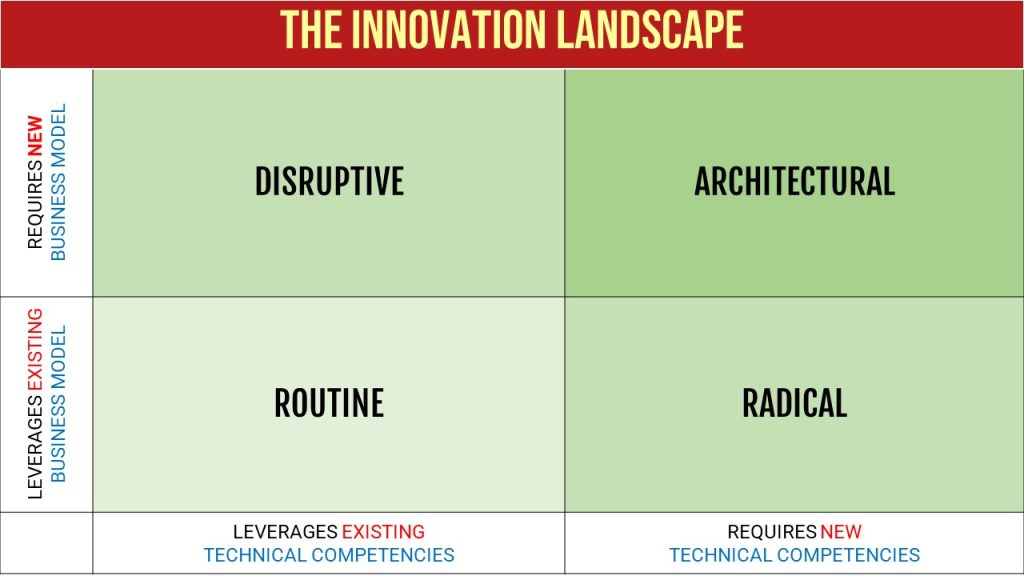The Innovation Landscape Map provides a practical guide for businesses navigating the complex terrain of innovation. It classifies innovation into four distinct categories based on two key dimensions: changes in technology and shifts in business models. This map is crucial for businesses seeking to innovate. It helps them identify the type of innovation most aligned with their goals and market context. By understanding where their efforts fall on this map, companies can strategically plan their innovation initiatives.

A. Routine Innovation
Harnessing Existing Technology and Existing Business Model
In the dynamic world of business, “routine innovation” emerges as a strategic cornerstone for companies seeking steady growth and sustainability. Unlike radical or disruptive innovations, routine innovation operates within the framework of a company’s existing technological competencies and existing business models, catering to and evolving with its existing customer base.
Example of Intel’s Microprocessor
Consider the case of Intel, a titan in the technology industry. Intel’s strategy of routinely launching more powerful microprocessors is a textbook example of routine innovation. This approach, grounded in the company’s deep technological expertise, has enabled Intel to maintain high profit margins and fuel growth for decades. Each new microprocessor release builds on the last, offering improved performance and features, yet remains within the company’s well-established area of expertise.
The Significance of Incremental Advancements
Routine innovation is characterized by incremental advancements rather than industry-shaking disruptions or technological leaps. This strategy allows companies to continuously improve their products, keeping them relevant and competitive in the market. It’s about refining and optimizing, rather than reinventing the wheel with each new iteration.
The Role of Familiarity and Reliability
In a market often dazzled by the newest and most groundbreaking developments, routine innovation offers a sense of familiarity and reliability to consumers. For loyal customers of brands like Microsoft and Apple, new versions of Windows or the latest iPhone model represent a promise of improvement without the anxiety of drastic change. These incremental innovations assure customers that they are getting something better, yet comfortably familiar.
Other Industry Examples
The concept extends beyond the tech industry. From automotive manufacturers that release updated car models each year to fashion brands that introduce new seasonal collections, routine innovation is a widespread approach. It’s about keeping a product line fresh and appealing, ensuring that a brand remains at the forefront of its customers’ minds.
The Steady Path to Longevity
Routine innovation is a testament to the power of consistency in the business world. It emphasizes the importance of building on existing strengths and understanding the needs of your customer base. In a landscape where radical changes grab headlines, routine innovation is the steady, often unsung hero driving long-term success and stability for many companies.

B. Radical Innovation
New Technology with Existing Business Model
In a world where change is constant, “radical innovation” stands out as a beacon of transformation. Unlike disruptive innovation, which shifts market dynamics, radical innovation is a deep dive into uncharted technological waters. It’s a story of how emerging technologies redefine industries, exemplified by the evolution of drug discovery in the pharmaceutical sector.
The Example of Biotechnological Revolution
Picture the late 20th century. The pharmaceutical landscape was on the brink of a revolution. The traditional approach to drug development, heavily reliant on chemical synthesis, was about to be transformed. Enter genetic engineering and biotechnology in the 1970s and 1980s. This wasn’t just a shift; it was a leap into a new realm of possibilities.
The Hurdle for Established Pharma
For decades-old pharmaceutical companies, this wave of radical innovation brought a significant challenge. The hurdle was not market adaptation but technological adaptation. Developing competencies in molecular biology, a stark contrast to their expertise in chemical synthesis, required more than just a strategic shift. It demanded a reinvention of their R&D methodologies.
A Seamless Business Model Integration
However, there was a silver lining. The emerging biotechnological drugs aligned well with the existing business models of these companies. The pharmaceutical industry, known for its heavy investments in R&D, found a new avenue for applying its resources. The high-margin products, a characteristic of this sector, were well-suited to absorb the financial demands of biotechnology research.
The Outcome: A New Era in Drug Discovery
The integration of biotechnology in drug discovery marked a new era. It showcased how radical innovation could be seamlessly integrated into existing business structures, provided there is a willingness to adapt and invest. This technological leap did not just bring new products to the market; it reshaped the very fabric of drug development, emphasizing the power of biological processes over chemical synthesis.
Embracing the Radical
Radical innovation is a testament to the limitless potential of technology. It reminds us that the greatest advancements often lie beyond the comfort zone of established practices. For industries worldwide, especially those rooted in science and technology, the lesson is clear: Embrace the radical, for it paves the way to the future.
C. Disruptive Innovation
Existing Technology with New Business Model
Disruptive innovation is intriguing in its simplicity and impact. It challenges and transforms the conventional business models of competitors, often catching them unprepared. This strategy does not necessarily hinge on advanced technology; rather, it leverages a novel approach to business, making it a unique and potent market force.
The Android Example
Consider the case of Google’s Android operating system. Its emergence in the mobile device market offers a classic example of disruptive innovation at work. Android’s disruption of giants like Apple and Microsoft wasn’t rooted in a significant technological leap. Instead, it was Android’s business model that shifted the market dynamics. By offering its operating system for free, Google challenged the fundamental revenue models of its competitors, whose operating systems were priced products.
The Ripple Effect of Free OS
This radical approach of offering a free operating system had far-reaching implications. It not only provided a cost-effective alternative for mobile device manufacturers but also expanded the potential user base exponentially. This model forced competitors to reevaluate and adapt their strategies in a market where the price of the operating system was a critical factor.
The Broader Impact on Industries
The concept of disruptive innovation, as exemplified by Android, extends beyond the technology sector. It’s a universal strategy relevant across industries. Companies that successfully employ this tactic can transform entire markets, often leading to increased consumer choice and more dynamic market conditions.
Embracing Disruptive Strategies
Disruptive innovation serves as a powerful reminder that in business, it’s not always the most technologically advanced player that leads the pack. Often, it’s the one with the most innovative business model. For companies striving to stay ahead, understanding and potentially adopting disruptive innovation strategies can be the key to longevity and success in an ever-changing business landscape. Uber’s revolution of the taxi industry and Netflix’s transformation of home entertainment are classic cases of disruptive innovation.
D. Architectural Innovation
New Technology and New Business Model
In the dynamic world of technological advancements, architectural innovation stands as a testament to human ingenuity. This phenomenon is not just about inventing new technologies; it’s about revolutionizing the very fabric of how businesses operate. A classic example? The shift to digital photography—a seismic change that shook giants like Kodak and Polaroid to their core.
The Example of Kodak and Polaroid
Imagine, for a moment, companies deeply entrenched in the world of film photography. Their expertise? Film, paper, processing chemicals. Their bread and butter? The “disposables” that photographers needed time and again. Then came the digital revolution.
For these titans, the digital era was more than just a technological shift. It was a complete overhaul of their competencies. They were now stepping into a realm of solid-state electronics, camera design, sophisticated software, and advanced display technology. It was a journey from the familiar into the unknown.
The Challenge: More Than Just Technical Mastery
The true essence of architectural innovation lies in its dual demand: mastering new technologies and reimagining business models. For Kodak and Polaroid, this meant not just developing new products but finding novel ways to generate profit.
Gone were the days when the sale of film and other disposables was the financial backbone. The digital age demanded a shift in focus—earning profits from the cameras themselves. This was a dramatic change in how these companies perceived their products and their market strategies.
Why Architectural Innovations Are Daunting
Architectural innovations, like the shift to digital photography, are particularly challenging for established companies. Why? Because they demand a two-fold adaptation process. Firstly, there’s the need to acquire or develop new technological skills—a feat in itself. But more critically, there’s the need to overhaul existing business models.
This means rethinking market strategies, revenue streams, and customer engagement tactics. For companies built and sustained on traditional models, this can be an uphill battle. It’s not just about being technologically innovative; it’s about being strategically visionary.
A Lesson in Adaptability and Vision
The journey of Kodak and Polaroid in the digital age is more than a tale of technological evolution. It’s a story of strategic resilience, adaptability, and foresight. It serves as a powerful reminder that in the world of business, innovation is not just about creating new technologies—it’s about redefining how we do business.
Architectural innovation challenges us to look beyond the known, to reimagine our competencies, and to be bold in our strategic transformations. It’s a complex dance of technology and business, one that requires vision, courage, and an unyielding drive to adapt and thrive.
Choosing the Right Type of Innovation for Your Business
Selecting the appropriate type of innovation for your business hinges on a deep understanding of your market’s needs and your own business objectives. It requires an analysis of where you stand in your industry: Are you a market leader, or are you trying to disrupt established players? Are you looking to enhance your current offerings, or are you aiming to venture into new markets? Answering these questions will guide you towards the innovation type that aligns best with your strategic goals.
Conclusion
Understanding the diverse types of innovation is paramount in today’s rapidly evolving business landscape. The Innovation Landscape Map provides a framework for businesses to categorize and comprehend various innovation strategies, empowering them to make informed decisions about their innovation efforts. As businesses strive to stay relevant and competitive, embracing the right type of innovation tailored to their unique needs and market dynamics is crucial.



